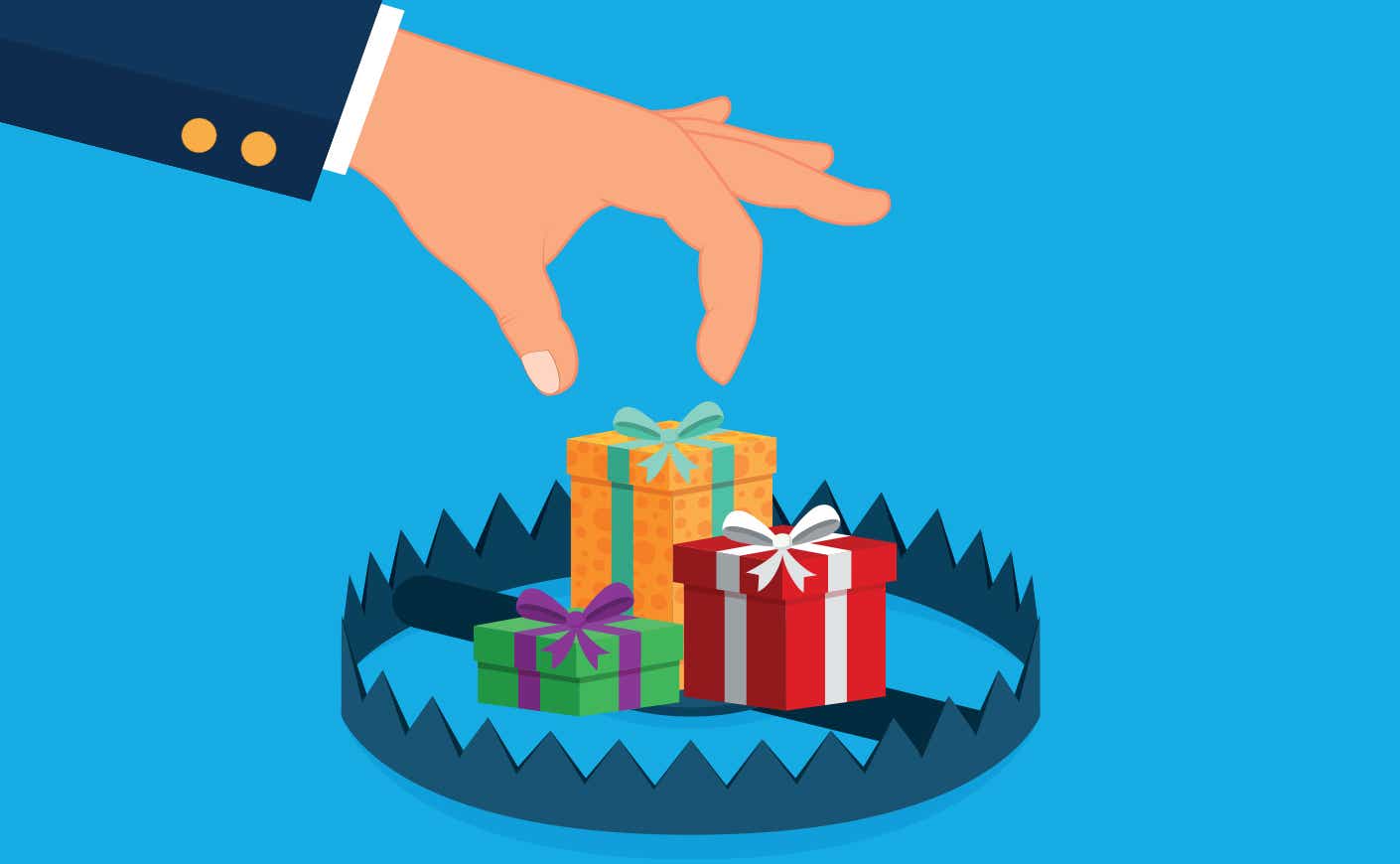Scams are getting more and more sophisticated these days, thanks (or no thanks) to technology like A.I., phone number spoofing, and ever-convincing phishing emails.
Sometimes, you might think something is a scam, but it’s not immediately clear what the scammer would even get from you — like when I got an obviously fake email from a well-known fashion retailer claiming (with many typos) that they wanted to hire me as a brand ambassador. After sinking too much of my time into corresponding with this scammer so I could figure out what the con even was, I discovered the “brand” would send me a bunch of clothes — but only after I paid for the shipping. (It seemed like a lot of work for $15 in shipping charges, but then again, they’d probably steal my credit card info in the process.)
Similarly, if you ever get a surprise delivery of items you never ordered, you might not realize it’s fraud right away, since you’re ostensibly getting a gift — but an expert warns the aforementioned scenario is a dangerous grift you should know about.
What is a brushing scam (and what’s different in this latest iteration)?
The financial experts at Clark.com want to put consumers on notice about a new type of scam. It’s an updated twist on an existing scheme called “brushing,” which the U.S. Postal Inspection Service explains happens when a person receives a package of items they didn’t order. The recipient doesn’t usually complain because, hey, free stuff. The scam is that the retailer, usually a third-party international seller, is sending cheap goods to unsuspecting people so they can write fake positive reviews of their store under the “customer’s” name. People who’ve been brushed might not be out any money, but their names are unwittingly being used by a scammy store to attract more customers with their inflated ratings and falsely positive reviews.
But recently, brushing has gotten an update that can put the recipient at risk. It’s the same general idea: You get a package of random stuff in the mail that you didn’t order. But now, that package comes with a QR code and instructions to scan the code to learn who sent you the “gift.” If you scan the code, that’s where the real trouble begins: USPIS warns that you could be exposing your sensitive information to scammers. Or, as Clark puts it, “you’re giving criminals a path into your phone to steal all your personal information.”
USPIS says the best course of action if you think you’ve been brushed is to return the package to the sender if it’s unopened. If you’ve already ripped into the box, you can toss the items if you don’t like them — or you can keep them under no obligation to pay, no matter how much the sender tries to talk you into coughing up money for the parcel. You’ll also want to monitor your banking activity, change any passwords, and keep an eye on your Amazon or eBay accounts for any fake reviews under your name. If you spot them, you can file a fraud report on the company’s website.
Of course, on the wild west of the internet, this is only one example of the creative ways fraudsters try to pull one over on you. Let’s pull back the curtain on a few more.
Other Scams to Be Aware Of
Zelle Scam
Last year, Bank of America warned customers about a sophisticated scam involving Zelle. It starts like this: You get what appears to be an automated text to your phone asking you to verify a suspicious charge. Before you can mark the charge as fraud, you immediately get a phone call from someone purporting to be in Bank of America’s fraud department. That person tells you that someone’s trying to make unauthorized purchases with your Zelle account — and in order to stop it, you just need to send a bit of money via Zelle to the email or phone number they provide. Little do you know, you’re sending money right into the scammer’s pocket.
What’s extra nefarious is that the scammers are in tune with the actual steps your bank would take to prevent you from fraud, so once you initiate the fraudulent Zelle transfer, the person on the phone will warn you that Bank of America is about to send you a fraud alert, and they’ll instruct you to ignore it because everything’s fine. So you listen to the scammer and bypass your actual bank trying to protect you from the very transaction you’re about to make.
Bank of America told ABC, “Bank of America will never ask a client to send money to themselves or anyone, ever. When sending money using Zelle, clients receive several messages alerting them to red-flags that indicate a scam. Clients with questions should call the customer service number on their debit or credit card or bank statement to confirm any questionable or fraudulent inquiries.”
If you get a call from anyone claiming to be your bank’s fraud department, your best bet is to hang up and call the fraud department back yourself using the number on your credit or debit card, just to confirm who you’re really speaking with.
Phone call scam
Phone scams aren’t anything new, but thanks to A.I., they’re getting a lot more convincing — and therefore, a lot more dangerous.
Here’s one common version: Someone gets a call from an unknown number, and a voice at the other end claims to be a beloved relative — a child, grandchild, niece or nephew, etc. — who’s in some sort of legal trouble, or maybe they were in a car accident. Whatever the reason, they need money for bail, or some other urgent expense, and fast.
Before you know it, they put their “lawyer” on the phone to demand the cash, and they might even say they’re sending someone to your home to pick it up. The scam is that your loved one is fine — they were never on the phone at all; the scammers were using an A.I.-generated version of their voice — and you just sent that money to a con artist.
This type of scam relies on victims feeling rushed, harried, and panicked. The easiest way to avoid this con is, if you get a frantic call like this, hang up and call your loved one back. If they pick up and everything’s fine, you dodged a bullet. Experts also recommend doing some proactive prevention and coming up with a safe word to use so you know if they’re really in trouble. Or, you could ask them a simple question only they would know the answer to — not anything that could easily be found or purchased online, like their date of birth or address, but what was on the menu during your last dinner together could work.
The one where you’re in trouble
Again, this isn’t a new scam, although it did gain heightened visibility thanks to a viral essay in The Cut last year. In that piece, financial columnist Charlotte Cowles described getting a phone call from someone who purported to be from Amazon, asking her to verify some suspicious charges on her account. There weren’t any suspicious charges — and, paradoxically, that’s where the scam began. The con artists on the phone told Cowles she’d been the victim of fraud and identity theft, and that her identity was linked to a slew of crimes in various states. The particulars of the scam Cowles fell victim to were pretty unique — taking $50,000 cash out of her bank, putting it in a shoebox and handing it to someone purporting to be an undercover agent — but the broad strokes of having a scammer convince an unsuspecting mark that they’ve been the victim of fraud or some other crime is a common tactic.
If you get this type of call, you should verify any charges independently via your accounts at Amazon and your bank — and get in touch with your bank if someone has accessed your account without authorization.
Wrong number scam
This is different from the phone call scam above, and it starts out so innocently, many people wonder what the scam could possibly be. It begins with a text that seems to be clearly meant for someone else. It might say something like, “Emily, I am looking forward to our dinner” or, as one NBC News reporter encountered, “Una, good evening, tomorrow morning the contract time of 10 a.m. is shifted to 3 p.m. for signing, I don’t feel well, I need to go to the hospital tomorrow morning to see the doctor.” The key is that the text won’t sound suspicious, and it will seem like something that’s clearly meant for someone else.
The goal is to entice the recipient to reply to let the sender know they have the wrong number. From there, over-the-top embarrassment followed by flattery will ensue — think something like, “I can tell you’re such a kind person.” Once the scammer knows they’re texting with a real person, they may try to move you to WhatsApp or another encrypted messaging service. From there, a version of the pig butchering scam tends to follow, where the fraudster will try to get their mark to buy or send crypto.
It’s a long and convoluted scheme for sure, but the big takeaway is that if you get a text from an unknown number, don’t respond.
Emails from social networks
This one’s just a riff on the classic phishing scam. You’ll get an official-looking email that purports to come from Instagram of Facebook. The message contains an official logo, with no typos in sight, and it claims that one of your posts included a copyright violation.
No matter how legit the email looks, don’t click it! Otherwise you may have just given criminals access to your sensitive data, including your social media and email accounts. If you did indeed commit a copyright infringement, Instagram or Facebook will notify you in the app. Make sure to not click on any links in the email and report the phishing attempt with your email provider.













